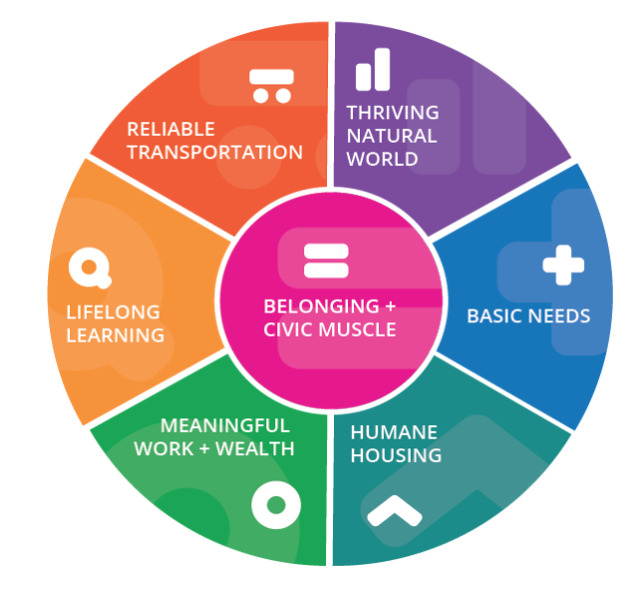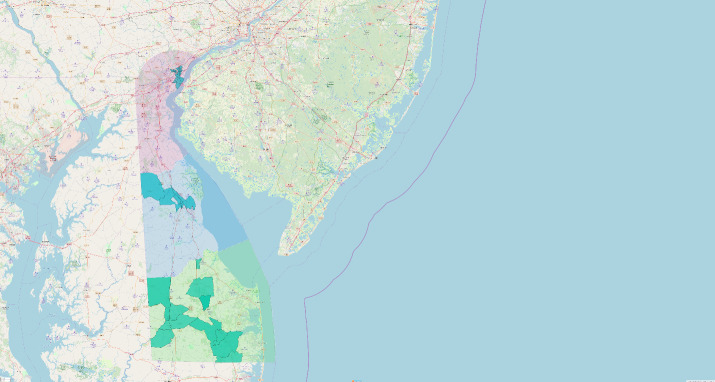Abstract
Healthy Communities Delaware (HCD) is a place-based initiative to improve health, well-being and equity across Delaware. HCD is a network of community-based and investment partners working to create thriving communities through improvement in the vital conditions. Vital conditions are the components of communities that we all need, all the time, to thrive and reach our full potential-- humane housing, a thriving natural world, lifelong learning, meaningful work and wealth, reliable transportation, basic needs for health and safety, and a sense of belonging and civic muscle. HCD invests in communities through community-based organization partners, who work to improve the vital conditions in their communities, informed by data and resident priorities. The key tenets of the Healthy Communities Delaware approach--place-based, community-driven, equity-focused and improving the vital conditions—work together to create more communities of opportunity across Delaware.
Healthy Communities Delaware
Place matters when it comes to health and well-being. Communities across Delaware look starkly different when it comes to life expectancy and quality of life outcomes. In a few census tracts in Delaware, residents live an average of 86 years.1 In other census tracts, residents can expect to live for only 68 years -- an 18-year difference, based on “place.” This is in large part due to the difference in community conditions that either support or hinder well-being and opportunity. These community conditions do not occur by chance; they are the result of policies, systems, and inequitable distribution of power.
Up to 80% of our health is influenced by what many call the social determinants of health--the conditions in the places where people live, learn, work and play that influence our health.2 Over the past few years, the field has adopted a more holistic way of thinking about these community conditions, using the Vital Conditions for Health and Well-Being Framework (Figure 1).3 Simply put, the Vital Conditions are the things that all people need all the time to be healthy and well, and to reach their full potential. These include reliable transportation, meaningful work and wealth, lifelong learning, basic needs for health and safety, humane housing, a thriving natural world and belonging and civic muscle. Each vital condition is distinct and necessary, and together they form an interdependent system that impacts community and individual health and well-being.
Figure 1.

The Vital Conditions for Health and Well-Being
The presence or absence of the vital conditions in our communities shapes our opportunity to thrive. There are significant inequities in communities across Delaware when it comes to the vital conditions. In some neighborhoods it’s easy to walk or bike to a local park or playground; homes are warm, dry and safe; we can easily drive or take a short bus ride to the grocery store; and there are quality learning opportunities for children, youth and adults. In other neighborhoods, there are no parks within walking distance; there is frequent gun violence which both injures children and keeps them indoors; public transportation to work and the grocery store is unavailable or inefficient; homes are deteriorating, unsafe and unhealthy. Many of these differences are due to legacies of harm and exclusion, most notably structural racism against Black, Brown and Indigenous communities.4
The Healthy Communities Delaware (HCD) initiative was created to support communities in improving the vital conditions in order to improve health, well-being and equity. Healthy Communities Delaware is a network of investment and community-based partners working to create healthy, safe and vibrant communities across Delaware. It is managed as a collaboration among the Delaware Division of Public Health, the University of Delaware Partnership for Healthy Communities and the Delaware Community Foundation.
The Healthy Communities Delaware network is made up of 18 community-based organizations and five investment partners working to advance the vital conditions in local neighborhoods. HCD focuses on communities that have suffered decades of disinvestment and the resulting health and social inequities--those communities that have the most to gain. Communities of interest are identified by having a high-risk score on the Social Vulnerability Index2 and/or the Area Deprivation Index.5,6 The Social Vulnerability Index combines 15 census variables to identify communities that may need support before, during or after disasters. The Area Deprivation Index measures neighborhood disadvantage through a 17-indicator index across the domains of income, education, employment and housing quality.
With the goal of becoming HCD partners and receiving investment and support, an initial group of community-based organizations or coalitions responded to a request for proposals (RFP) in April 2020. Eleven were selected for long-term collaboration and investment. An additional seven communities were added to the network in July 2022 through a similar RFP process. Healthy Communities Delaware community-based partners are working to improve the vital conditions in the communities mapped in Figure 2.
Figure 2.
Healthy Communities Delaware Partner Communities (2022)
Many communities approach community development and improvement of the vital conditions as a process of forming partnerships, assessing needs and strengths, prioritizing and planning, implementation and evaluation. Healthy Communities Delaware engages community partners at whatever stage they may be in this process. HCD investment can support any stage of the work as well as capital, staff and capacity building costs. In many cases the stabilizing investment from HCD supports community-based partners to leverage significant additional funding to advance their work.
One of the core tenets of Healthy Communities Delaware’s approach is that residents of the communities themselves have prioritized the work proposed for investment. Lived experience in a place gives one an intimate knowledge of context. The people who live in a community are best positioned to understand challenges and assets, and therefore to inform and be engaged in implementing solutions. Because of this approach, HCD community partners are addressing a variety of the vital conditions within and across communities. Some are building affordable housing, repairing homes, and revitalizing parks and playgrounds. Others are increasing early learning opportunities, creating community gardens, or conducting workforce development activities. Others are at the beginning of their journey, and are developing community assessments to understand assets and challenges. Most communities are working on advancing several of the vital conditions at the same time, in the spirit of comprehensive community development.
Over the last two years of HCD investment (July 2020 – June 2022) the original eleven community-based partners have made significant progress in improving the vital conditions in neighborhoods across Delaware. Some of these achievements include: six community action plans and needs assessments created; three community gardens created/maintained; over 450 neighborhood revitalization services completed (homes, community, business); 28 affordable housing units in progress; two park/playground designs created; seven residents received leadership training; and more.
Work to improve the vital conditions is a long game--we must be committed for decades to come. Inequities have been created by policies and systems that were never built for all people to thrive. These inequities have been created over generations, and will take generations to change. Repair of these conditions is not sufficient; renewal both in terms of process and outcome is necessary.
People who are experiencing the effects of structural inequities often have the least power to change the systems that are perpetuating them. Power is derived from relationships, access to resources, opportunity to participate in decision-making, and the dominant narratives of American society. Community power-building is recently being recognized as a strategy to improve health equity.7 Healthy Communities Delaware works to acknowledge and advance community power-building through our processes and in the near future, will do so through explicit power-building strategies. Each step a community takes to make improvements can bring both physical changes in a community that we can see--a new affordable housing complex--as well as intangible assets like increasing a sense of belonging and connection among people and place. But to have both, intentionality to the process and goal of building community power is necessary.
Given the influence of place on well-being and quality of life, we must think and work holistically, across sectors, to improve the vital conditions for health and well-being. We must strategically increase and align investment in the communities that have the most to gain, shifting power to communities, and working together to create places where all people have the opportunity to thrive. The key tenets of the Healthy Communities Delaware approach--place-based, community-driven, equity-focused and improving the vital conditions—work together to create more communities of opportunity across Delaware.
References
- 1.Tejada-Vera, B., Bastian, B., Arias, E., Escobedo, L. A., & Salant, B. (2020). Life expectancy estimates by U.S. census tract, 2010-2015. National Center for Health Statistics. Retrieved from https://www.cdc.gov/nchs/data-visualization/life-expectancy/index.html
- 2.Centers for Disease Control and Prevention. (2022). Social vulnerability index. Retrieved from https://www.atsdr.cdc.gov/placeandhealth/svi/index.html
- 3.Community Commons. (n.d.) The seven conditions for health and well-being. Retrieved from https://www.communitycommons.org/collections/Seven-Vital-Conditions-for-Health-and-Well-Being
- 4.Centers for Disease Control and Prevention. (2021). Racism and Health. Retrieved from https://www.cdc.gov/healthequity/racism-disparities/index.html
- 5.Kind, A. J. H., & Buckingham, W. R. (2018, June 28). Making neighborhood disadvantage metrics accessible: The neighborhood atlas. The New England Journal of Medicine, 378(26), 2456–2458. 10.1056/NEJMp1802313 [DOI] [PMC free article] [PubMed] [Google Scholar]
- 6.University of Wisconsin School of Medicine Public Health. (n.d.). 2018 area deprivation index v2.0. Retrieved from https://www.neighborhoodatlas.medicine.wisc.edu/
- 7.Farhang, L., & Morales, X. (2022). Building community power to achieve health and racial equity: principles to guide transformative partnerships with local communities. NAM Perspectives. Commentary, National Academy of Medicine, Washington, DC. . Retrieved from https://nam.edu/building-community-power-to-achieve-health-and-racial-equity-principles-to-guide-transformative-partnerships-with-local-communities/ [DOI] [PMC free article] [PubMed] [Google Scholar]



